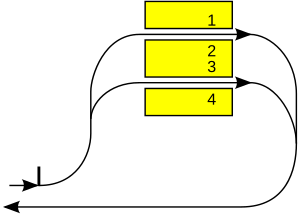Balloon loop facts for kids
A balloon loop is a special type of railway track that helps trains turn around easily. Imagine a giant loop of track that lets a train go in a big circle and come back facing the opposite direction. This means the train doesn't have to stop or do complicated maneuvers to change direction. It's super helpful for passenger trains and long freight trains that carry the same type of cargo, like coal.
Contents
What is a Balloon Loop?
A balloon loop is a curved section of railway track that forms a complete circle or a shape like a teardrop. It allows a train to enter one end, travel around the curve, and exit the other end, now facing the opposite way. This design is very efficient because the train doesn't need to unhook its engine or move cars around to change direction. It just keeps moving forward in a big circle.
How Do Balloon Loops Work?
Think of it like a car turning around in a cul-de-sac, but for a train! When a train reaches the end of its journey or needs to change direction, it simply drives onto the balloon loop. It follows the curved track all the way around until it has completed a full circle. By the time it exits the loop, the front of the train is now facing the direction it needs to go. This saves a lot of time and effort compared to other ways of turning trains around.
Why Are Balloon Loops Useful?
Balloon loops are very helpful for several reasons:
- Saving Time: Trains can turn around much faster. They don't need to stop, detach the engine, move it to the other end of the train, and reattach it.
- Efficiency: This design is great for trains that always carry the same type of cargo, like coal trains going from a mine to a power plant. They can quickly unload and turn around for the next trip.
- Less Shunting: Shunting means moving train cars around, often by pushing and pulling them with a small engine. Balloon loops avoid the need for this complex and time-consuming process for turning the entire train.
- Passenger Trains: For passenger trains, especially those on busy routes, a quick turnaround means less waiting time for passengers and keeps the train schedule running smoothly.
Where Are Balloon Loops Used?
You can find balloon loops in many places around the world where trains need to turn around frequently.
- Coal Mines and Ports: They are common at large coal mines or ports where trains deliver huge amounts of coal. The train can drive onto the loop, unload its cargo, and then immediately head back for more.
- Passenger Terminals: Some busy passenger train stations, especially those at the end of a line, use balloon loops to quickly get trains ready for their next journey.
- Tramways: Trams, which are like streetcars, also use smaller versions of balloon loops, often called "tram loops," to turn around at the end of their routes in cities.
Images for kids




